FIELD TRIPS
TWO MOSSES
There weren’t any photogenic mosses at the prairie so I scouted around the yard. The little brick wall in front of the house is home to Syntrichia papillosa, sometimes called “marble screw moss.” It doesn’t look like much now, being dry, except to serve as excellent example of how mosses are “poikilohydric,” meaning that they exist at whatever moisture level is the ambient on at the moment. They can dry to a crisp and stay alive until wetted again.
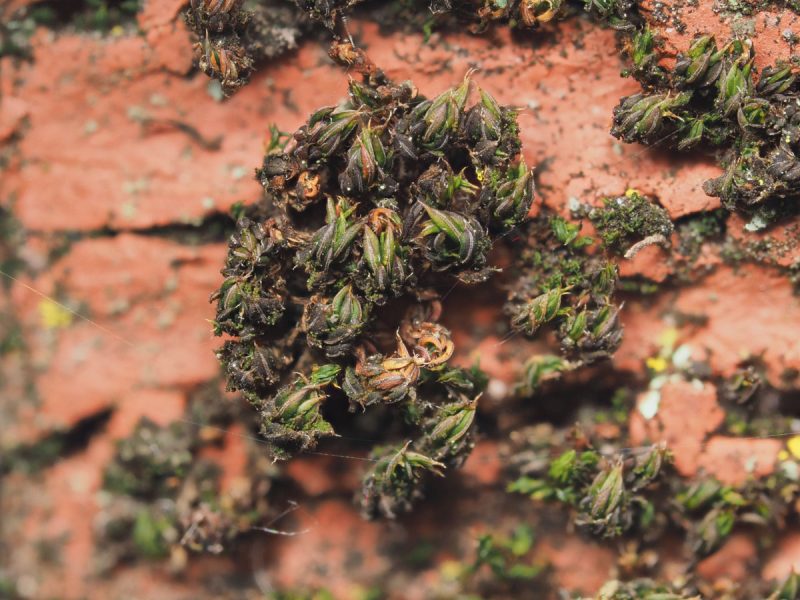
Marble screw moss is twisted when dry.
Here’s what marble screw moss looks like in wetter times. Not only is it open and well hydrated. Note the asexual reproductive propagules (gemmae) along the costa (indeed spread our across much of the leaf surface).
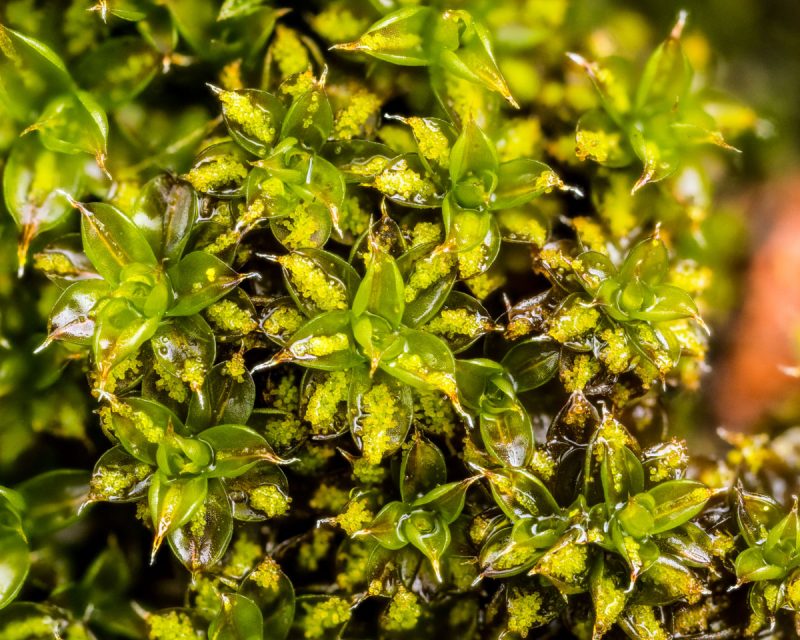
Marble screw moss in the rain.
A bare spot in the prairie garden is home to a pleurocarp (carpet moss) with costate leaves. They leaves are slightly folded longitudinally (plicate). Examination through the microscope confirmed this as a species of the challenging genus Brachythecium, the common B. laetum.
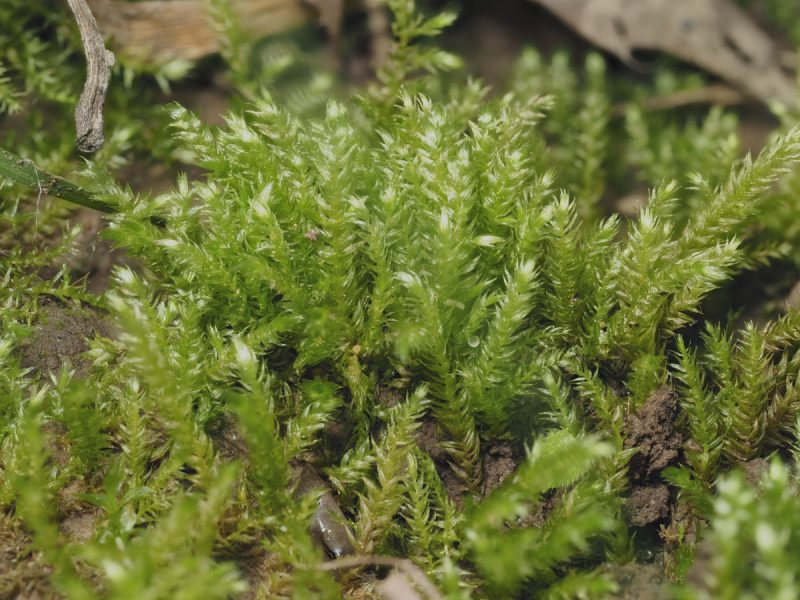
Brachythecium is a shaggy pleurocarp.
TWO FERNS
At the OSU-Marion Campus Prairie, there are two ferns. One of them doesn’t look very fern-like in the traditional sense. It’s common or field horsetail, Equisetum arvense. The stems are narrow, rigid, fluted longitudinally. They have a peculiar stiffness that is due to their containing silica deposits in the stem.

Field horsetail, is a seedless vascular plant.
Sensitive fern, Onoclea sensibilis is a more fernlike fern. It has a dimorphic frond type, wherein the fertile (spore bearing) fronds are dry, looking like rattles, The sterile (photosynthetic) fronds are pinnatifid. The name “sensitive” derives from a sensitivity to frost.
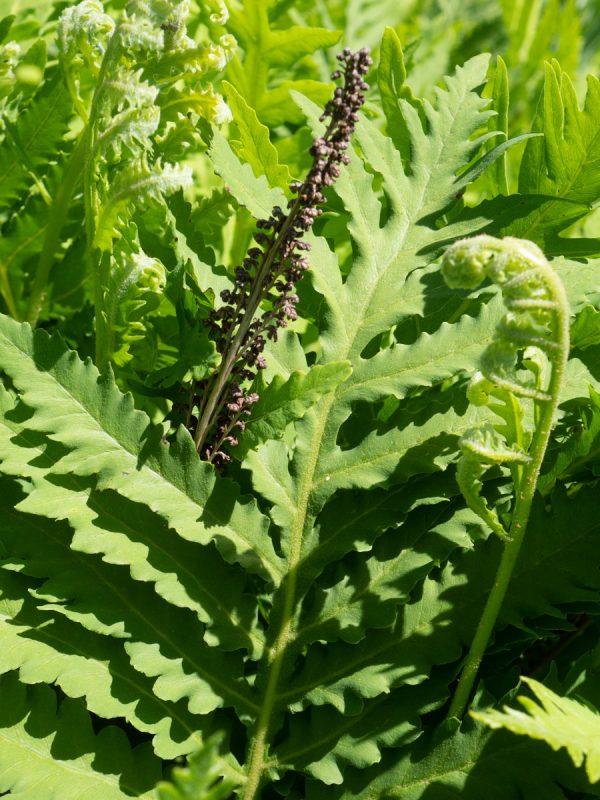
Sensitive fern is sensitive to frost.
LIME LOVING PLANTS
Ohio Plants explores natural areas in two markedly dissimilar regions of Ohio, and interprets them based on the analysis of geology and vegetation set forth in noted Ohio geologist Jane Forsyth’s 1972 article ““Geobotany: Linking Geology and Botany.” In is, she tells us that the Geology of Ohio is divided into two parts.
WESTERN OHIO: underlain by erodible limestone and dolomite.
The result after 200 million years of erosion is flat level landscape.
EASTERN OHIO: underlain by erodible shale capped by erosion-resistant sandstone.
There result after erosion is deep valleys of steep-sided sandstone hills.
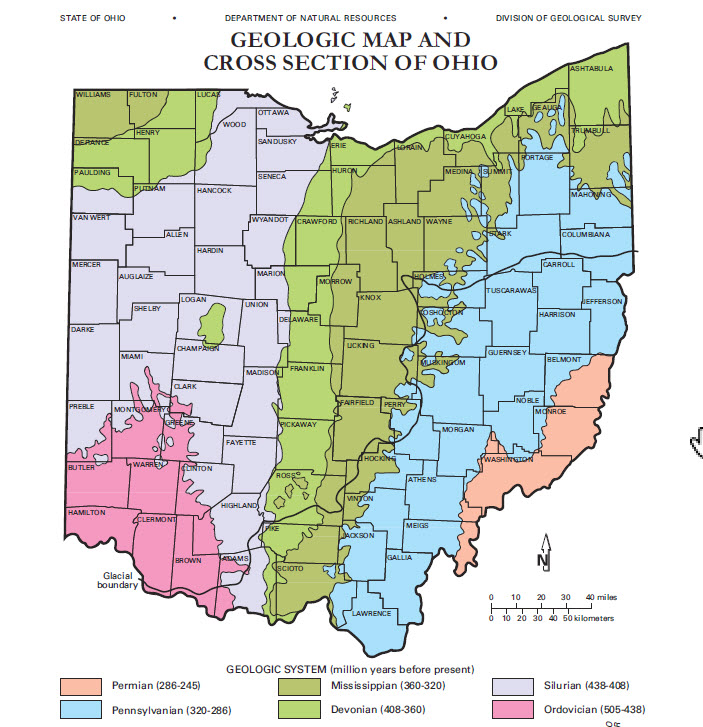
Geologic Map of Ohio
This has resulted in there being very different substrates for plants in the two parts of Ohio.
Last year I put together an Ohio Geobotany exhibit for the Museum of Biological Diversity Open House, and made this set of table based on Forsyth’s article. It fits in here too (hooray for recycling).

The characteristic plants of the more fertile and deeper soils found across the great till plains covering more than half the state are many majestic forest trees.
At the Ohio State-Marion Campus Prairie we don’t have any exposed limestone, but we do have high-lime clay-rich soil, and it is home to some of the trees with a fidelity to such sites.
TREES OF THE HIGH-LIME CLAY-RICH TILL OF THE WESTERN OHIO PLAINS

One such tree is bur oak, Quercus macrocarpa. I belive these individuals were planted here, in an attemot to replicate the vegetation of the Daughmer Bur Oak Savanna in neighboring (to the north) Crawford County. Bur oak ia a member of the white oak group;not the rounded lobes that are not bristle-tipped.

Bur oak leaf at Marion Campus Prairie
Pin oak (Quercus palustris) is a tree of low-lying areas. A member of the red oak group, note the bristle-0tipped lobes. The lobes in this species are narrower than out other red oaks.
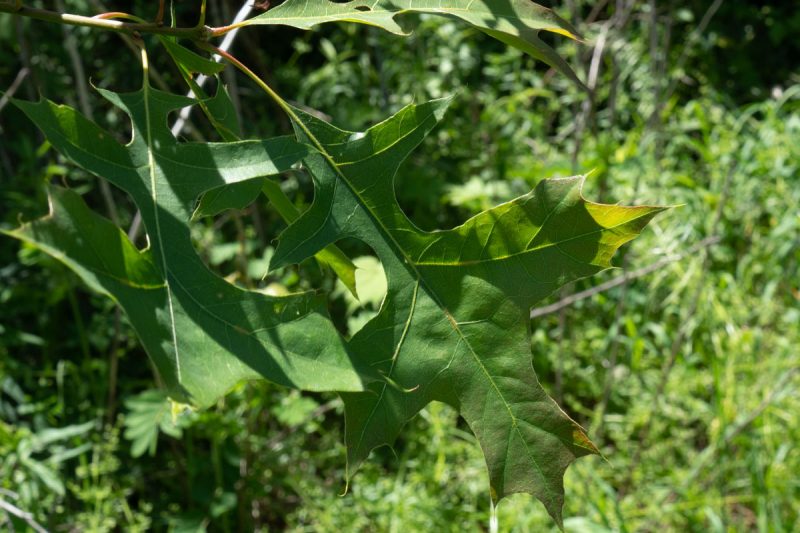
Pin oak has narrow bristle-tipped lobes.
PLANT-ANIMAL INTERACTIONS
(seed dispersal)
Here’s an annoying plant; it’s “cleavers” (also called “bedstraw”), Galium aparine, a member of the Rubiaceae, the madder family. It seems indeed to have anger management issues, grabbing on to passsers-by and not letting go. This is seed dispersal as a stick-tight, as passing animals carry the fruits.
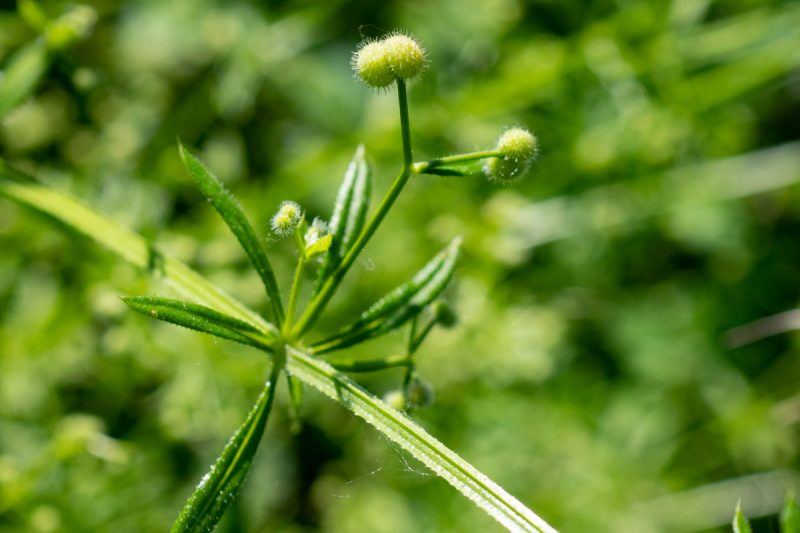
Meet cleavers (not “meat cleavers”)
The most obvious and common means of animal-mediated dispersal is for the fruits to be eaten, and the seed passed through the animal’s digestive tract, deposited some distance away along with some fertilizer. The common fruit type that is the drupe is especially well adapted for this, as the seed is protected by a hard bong endocarp. Cherries are drupes.
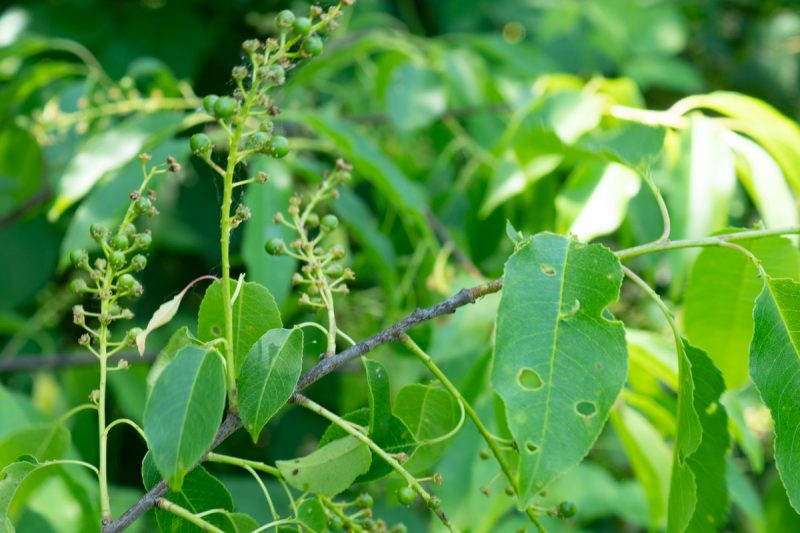
Black cherry, Prunus serotina, is a relatively late-flowering cherry. These drupes are starting to mature.
INVASIVE PLANTS
(Boo, hiss)
Restored prairie have a characteristic suite of problem plants. The restoration sites are often more fertile than are intact prairie, and so the prairie plants don’t have a competitive advantage here. Several so-called “nitrophilous” (nitrogen-loving) weeds do too well here. Some are grasses, such as this smooth brome (Bromus inermis).
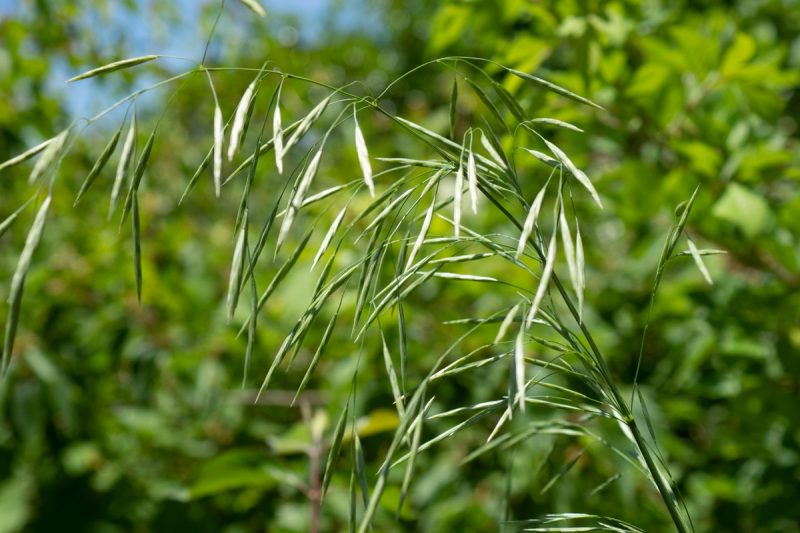
Smooth brome (Bromus inermis) is a cool-season grass that does too darn well in prairie restorations.
It is non-native.
Teasel (Dipsacus fullonum) is a weedy forb (i.e., herb that isn’t a grass or grass-like plant). Teasel is a biennial, producubg a rosette of leaves in its first year, and flowering, then dying. The specific epithet “fullonum” refers to its use by fullers, in the wool industry, wherein the hooked seed heads were used to fluff up the wool.
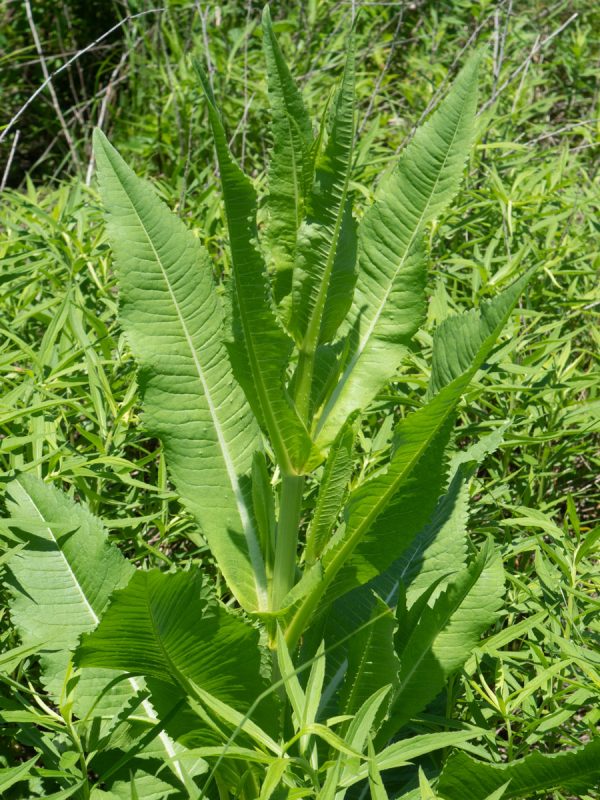
Teasel is a biennial weed of prairies and roadside.
MONOCOTS and DICOTS
In June the prairie finally wakes up! One of the mos striking wildflowers is Ohio spiderwort, Tradescantia ohiensis. Clearly a monocot; note its 3-parted flowers and linear parallel-veined leaves.
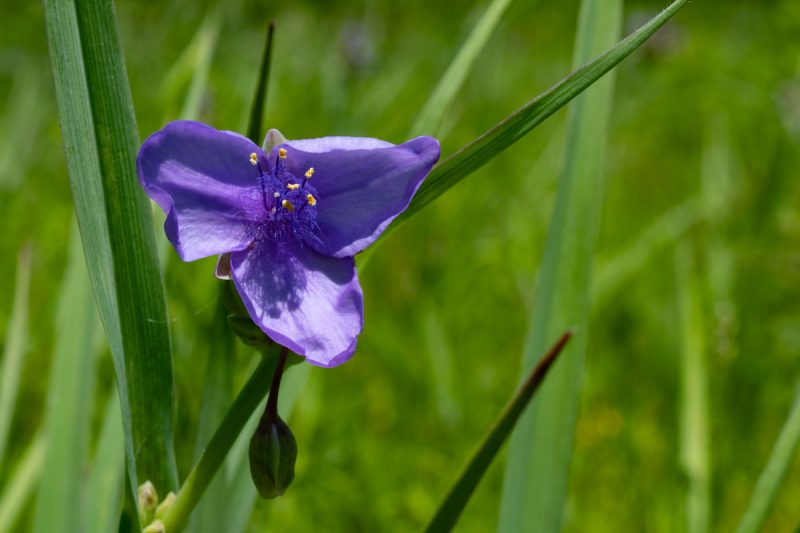
Ohio spiderwort (Tradescantia ohiensis)
Another monocot is very conspicuous this week. It’s southern blue flag iris, Iris schreberi.

southern blue flag, Iris schreberi
Iris flowers are more complicated than they look. As you’d expect for a showy monocot, there are 3 petals; there are also 3 colorful sepals. But there are surprises. First off, the broader yellow-blotched appendages are the sepals. not, as you might expect, the petals. The petals are spatula-shaped, and alternate between the sepals. Secondly, as you examine the photo above, a 3rd series of colorful appendages is apparent –those narrow strap-like things arching over the sepals. What are they? Styles! Colorful petaloid styles. And beneath each of them there is a stamen. Below see a flower slightly pulled apart to reveal the stamen, and alos the stigmatic surface: a little ridge on the underside, near the tip of the style.
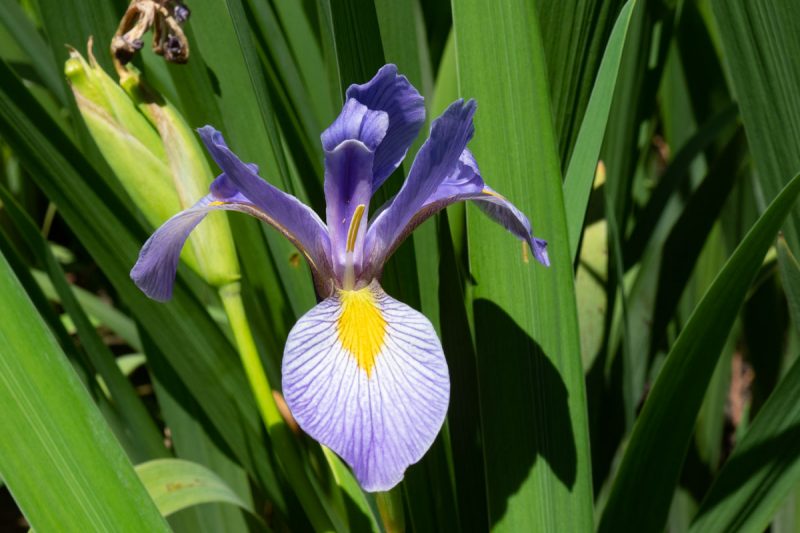
A slightly pulled-apart iris. note the petaloid style, the ridge-like stigmatic surface, and the stamen.
Dicots, by comparison, usually have flower parts in 4’s or 5’s, and broader, net-veined leaves. An especially abundant wildflwoer at this and most other prairies is foxglove beard-tongue, Penstemon digitalis, a member of the Plantaginaceae. Here the petals are fused, and the symmetry is bilateral. The genus name refers to a 5th “stamen” that is actually an non-fertile staminode.

foxglove beard-tongue
I especially like foxglove beard-tongue because it’s fun to pantomime its name, if you happen to have a fox on hand.
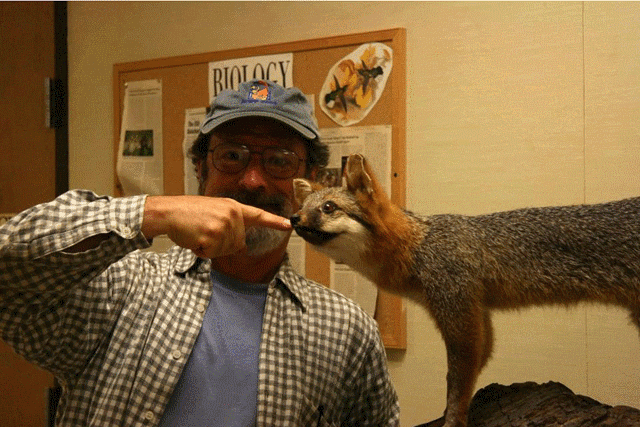
fox glove beard tongue fox glove beard tongue fox
Our first stop was a prairie-like wetland along Darby Creek Drive. This area was wisely purchased by Franklin County Metro Parks while it was farmland. It sits within the watershed of Big Darby Creek, a State and National Scenic River. This is a pristine watercourse known for its richness in fish and mussel diversity. Both to help protect the creek from run-off and create wildlife habitat on-site, the Parks people in 2010 restored natural hydrology by breaking drain tiles, and planted prairie grasses. It is now a magnificent wetland.
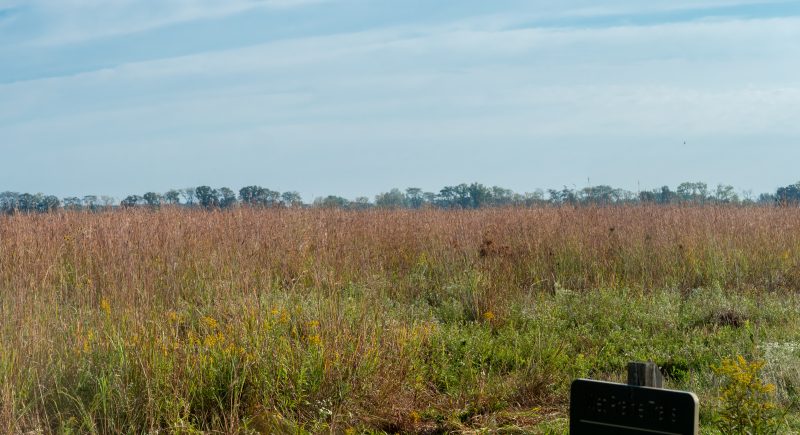
Marsh at Batelle Darby MetroPark.
The wetland is dominated by “graminoids,” i.e., herbaceous plants in the grass or sedge families, which are characterized by having long linear leaves and reduced wind-pollinated flowers. One of the graminoids is a Torrey’s rush, Juncus torreyii. It’s an especially robust rush, with globose heads of small flowers.
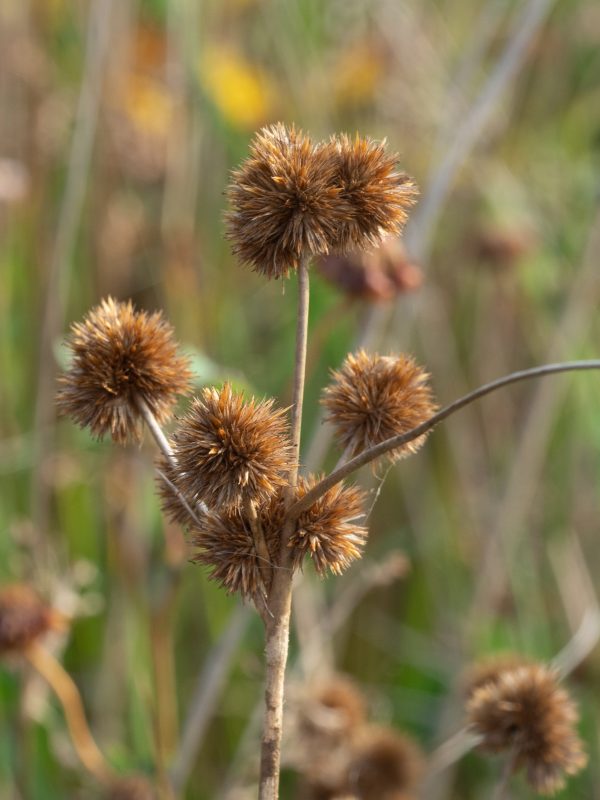
Rushes are graminoids with small flowers that resemble miniature lilies.
Some woody plants are beginning to colonize the wetland, including representatives of two genera in the willow family (Salicaceae). Eastern cottonwood, Populus deltoides is the most widespread of these.
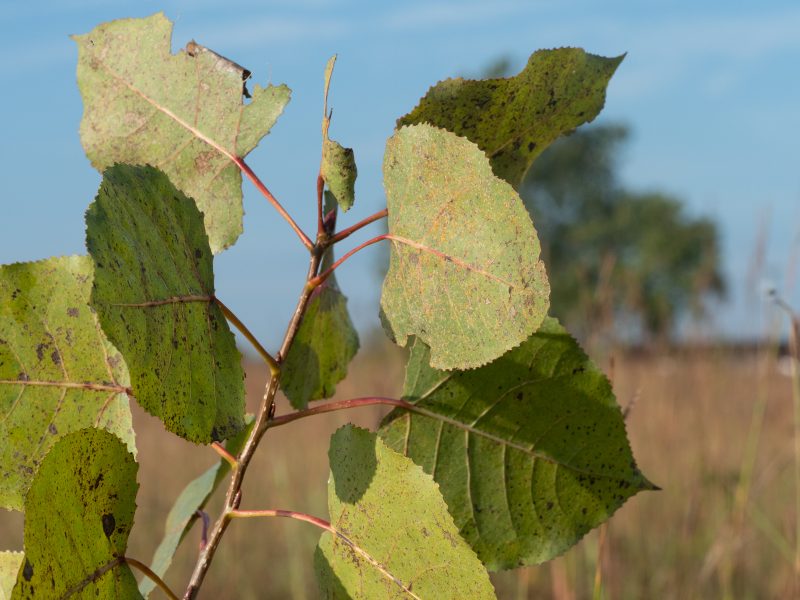
Eastern cottonwood has linguine leafstalks!
Another wetland woody is willow, genus Salix, distingusihed by having long narrow leaves. Most of our willows are shrubs, not trees. I forgot to take a photo of it, but still enjoyed observing it.
Willow has an interesting history as a medicinal plant. Ancient people in several parts of the world have used willow bark, sometimes administered by chewing twigs or a s an infusion (tea) as pain relief. The active ingredient, salicin, is the same as in aspirin, the technical name for which is acetylsalicylic acid –note the reference to the genus Salix in the chemical name!
From there we went to a prairie at the Indian Ridge section of the park. Although this region is within an area where, in pre-settlement time, there were scattered and in some places extensive areas of prairie, this site is not a natural remnant but rather a “restored” (planted) prairie. This is an example of a tallgrass prairie, dominated by, well, tall grasses, prominent among which is big bluestem, Andropogon gerardii. This grass is easily recognized by its clusters of a few one-sided spikes of spikelets that give it another common name, “turkey-foot.”

Big bluestem is a signature grass of the tallgrass prairie.
Other grasses that are abundant here are Indian grass (Sorghastrum nutans) and switchgrass (Panicum virgatum).
Prairie forbs (i.e., herbaceous plants that are not grass-like) are well represented by members of the aster and legume families, most of which were done blooming when we were there. The most conspicuous wildflower today is stiff goldenrod, Solidago rigida.

Stiff goldenrod is a prairie forb.
An hour later, we were at Cedar Bog (that isn’t a bog) in Champaign County. While we were there we kept our eyes open for plants that, according to Jane Forsyth in her brand-new forty-seven year old article “Linking Botany and Geology –a New Approach (The Explorer 1971), are limited to limestone or limey sites.

Plants of limestone areas, from the Jane Forsyth “Geobotany” article
We did see couple of these: hackberry (Celtis occidentalis) and chinquapin oak (Quercus muehlenbergii). Here’s the oak. Note that is it a member of the white oak group, as the leaves have rounded, not bristle-tipped lobes, and so shallowly lobed that they might be better considered serrate.
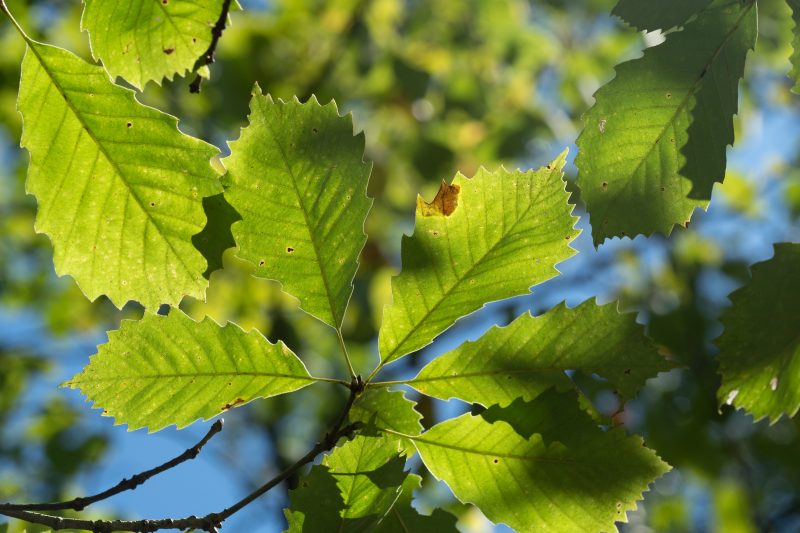
Chinquapin oak is a member of the white oak group.
It resembles chestnut oak, but has sharper lobes.
In the classic work “Woody Plants of Ohio” (1961) E. Lucy Braun presents a range map for chinquapin oak that seems to show it more widely ranging across Ohio than you would expect for a tree that is a pronounced calciphile. However, in the text she notes (p. 123) “…most common on the limestone soils of southwestern Ohio, a fact the distribution map does not show.” Below see the distribution maps of this species and a similar-appearing ine with a sharply different substrate affinity, rock chestnit oak, Quercus montata, a species we will be on our Hocking Hills trip.

Distribution maps for two members of the white oak group in Ohio
frm E. Lucy Braun (1961) The Woody Plants of Ohio (OSU Press)
Before entering the bog that isn’t a bog we were given an introductory presentation by the director there, Mike Kracken, who explained the difference between a bog and a fen, and why Cedar Bog is actually Cedar Fen! Bogs clog and fens flush…which is to say that fens are fed from underground springs that percolate up through the sediment which is rich in calcium minerals that become dissolved in the water. The spring were formed when glacial-transported gravel filled the valley of an ancient river system, the Teays (proniunced taze) River. The water is cool, which effectively shortens the growing season. Mike explained that Cedar Bog (which isn’t a bog) is unique in that plants from three different phytogeographic affinities are found in this one spot: northern bog plants, prairie plants and mid-western fen plants.
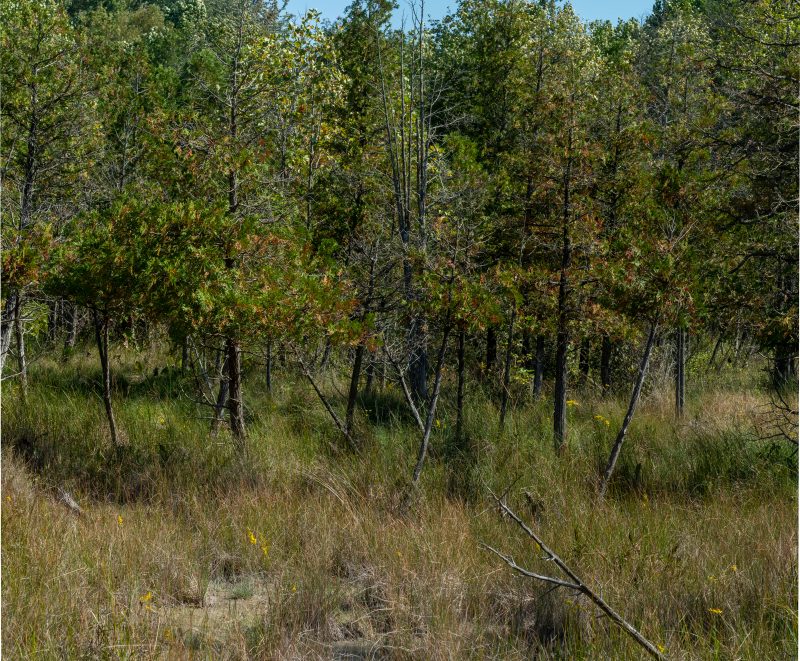
Marl meadow at Cedar Bog that isn’t a bog.
In addition to the eponymous Thuja (cedar) trees that were abundant, we saw a couple of unusual woody plants you are unlikely to see unless you are at a special natural area like this. Look but don’t touch, it’s poison-sumac, Toxicodendron vernix! This close relative of poison-ivy has the same allergenic component –a non-volative oil called urushiol, but its slightly different chemical form (something to do with side chains as mentioned in this Wikipedia entry) this species causes a more severe dermatitis. Yikes!

Poison-sumac is a high quality wetland sgrub.
Just don’t touch it!!
Poison-sumac is distinctive, if you look at the combination of characters, including the specialized bog or fen habitat. It has alternate pinnately compound leaves with entire (not toothed as in the “friendly” sumacs, i.e. smooth, staghorn, winged and fragrant (all in the genus Rhus), that are fairly large. In fruit, there are drooping racemes of white drupes. (Note the the aforementioned friendly sumacs all have red drupes.)
Another specialty of swamps is black ash, Fraxinus nigra. Ashes are annoyingly similar to one another, and to make matters even more confusing, all of our ashes have common names that are colors’ there’s black ash (Fraxinus nigra), white ash (F. americana), blue ash (F. quadrangulata), red ash (F. pennsylvanica), green ash (also F. pennsylvanica) and pumpkin ash (F. profunda). Wondering about pumpkin ash fitting into the name = color rule? It’s simple. A pumpkin is an orange fruit, and the other prominent fruit that is orange is called an “orange.” So therefore, the name of any fruit that reflects light in the ~ 635–590 nm wavelength range can officially serve as the word for that color. This must be true because I read it on the internet (never mind that I only just wrote it on the internet myself). Let’s celebrate! It’s Nationals Circuitous Logic Day!
To recognize this unusual ash, look for more a few more leaflets than you usually see on ashes, and note how they are attached to the rachis (leafstalk): they are sessile (non-stalked), in contrast to the stalked leaflets of our other ashes.
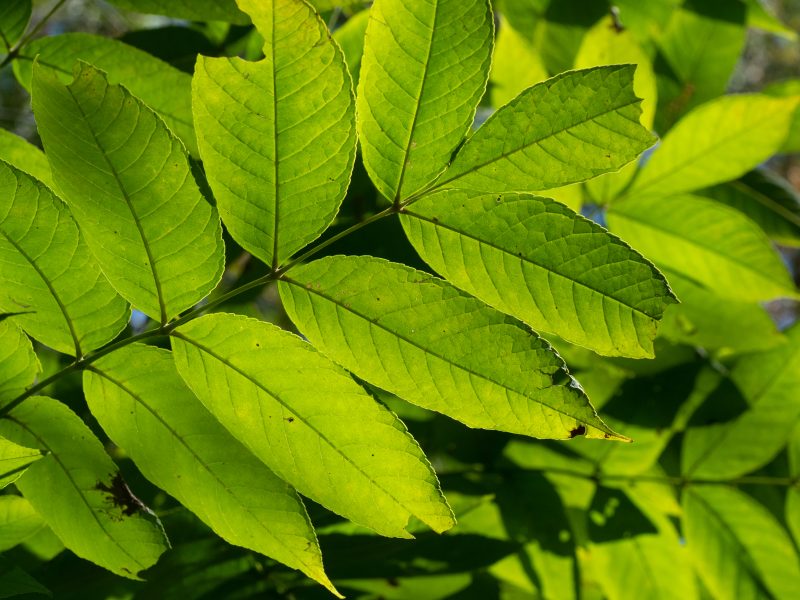
Black ash is a swamp tree.
There are a number of specialized herbs at Cedar Bog that isn’t a Bog. Among them is a thistle that looks a bit like the nasty evil invasive canada thistle but is actually a prized wildflower found in only a few places in Ohio: swmap thistle, Cirsium muticum is identified by its phyllaries (involucral bract) that are gummy-sticky instead of being sharp-pointed in other thistles (including some other very valued wildflowers such as pasture thistle).
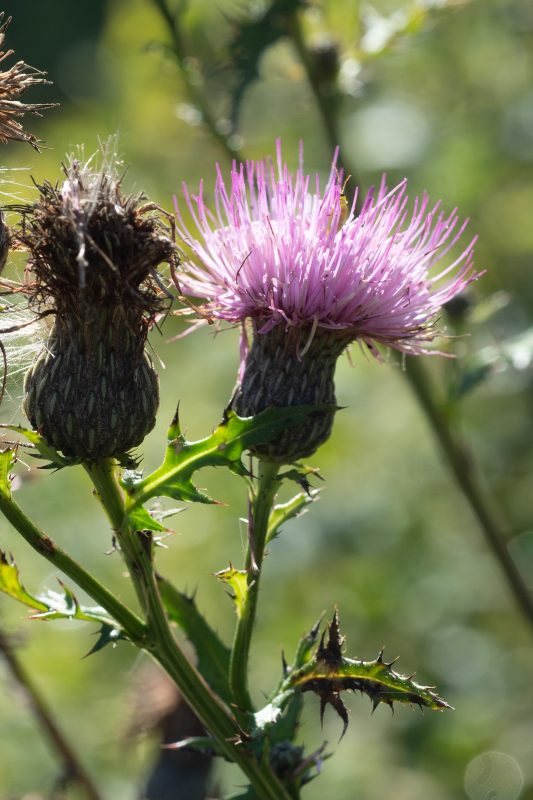
Swamp thistle has a sticky, not bristly, involucre.
Rare goldenrods! With their small capitula of bright yellow flowers arranged in a variety of compound inflorescence, goldenrods brighten the late-summer landscape. While several species, such as the ubiquitous Canada goldenrod, with a Coefficient of Conservatism of 1, are widespread along roadsides and meadows across the state, some are highly restricted to special habitats. Two such highly conservative (CC=9 for both) members of the genus Solidago are Ohio goldenrod (S. ohioensis) and bog goldenrod (S. uliginosa). Both are delicate, and each is fairly distinctive. Ohio goldenrod (not shown) is flat-topped, while bog goldenrod is wand-like.
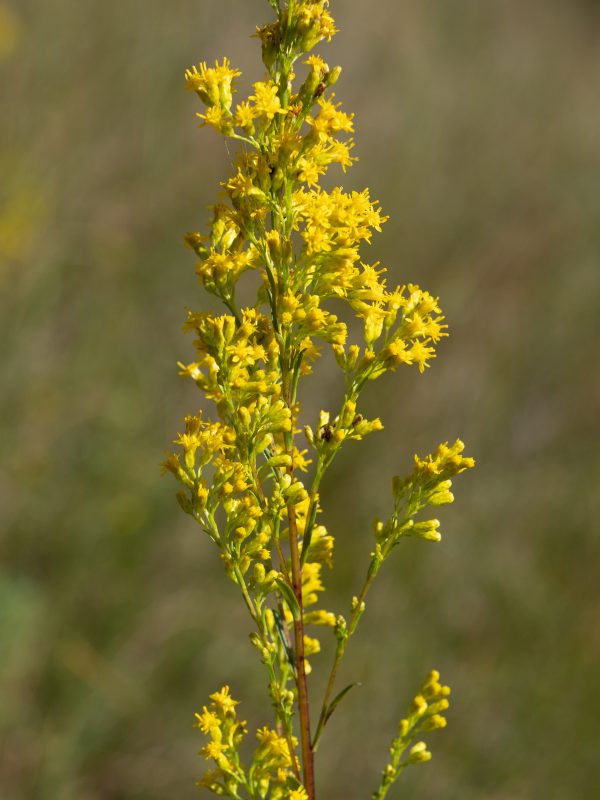
Bog goldenrod is wand-like.
Oh hip-hip-hooray! We finally got to see a flowering member of one of our “big eight” plant families, the Rosaceae. This is shrubby cinquefoil, Dasiphora (formerly Potentilla) fruticosa, a shrubby yellow-flowered plant that is actually common in cultivation. Note the rose family traits of regular (radially symmetric) flowers with 5 separate petals, many stamens and many carpels, spirally inserted. Too bad the photo doesn’t show the stipules on the leaves.
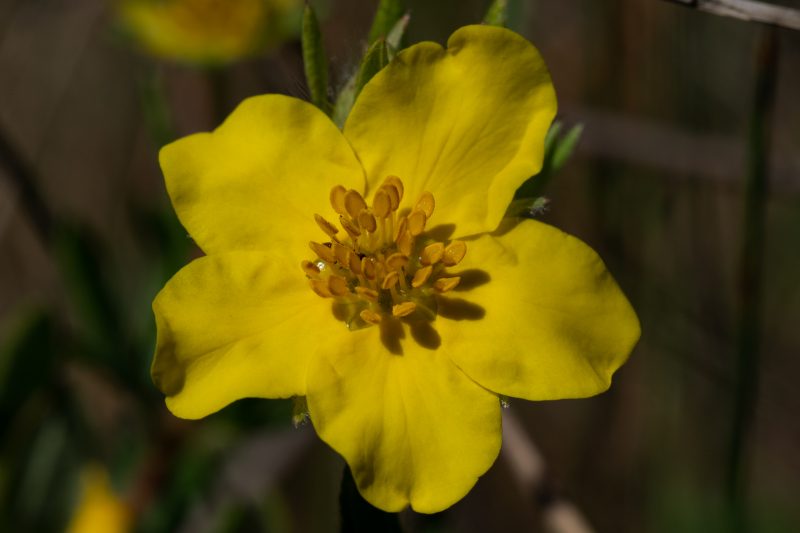
Shrubby cinquefoil is a shrub in the rose family.
There’s a wildflower here called “grass of Parnassus” that is definitely not a grass. The flowers of grass-of-parnassus flowers have five deeply 3-lobed nectariferous staminodes alternating with the pollen-producing stamens.
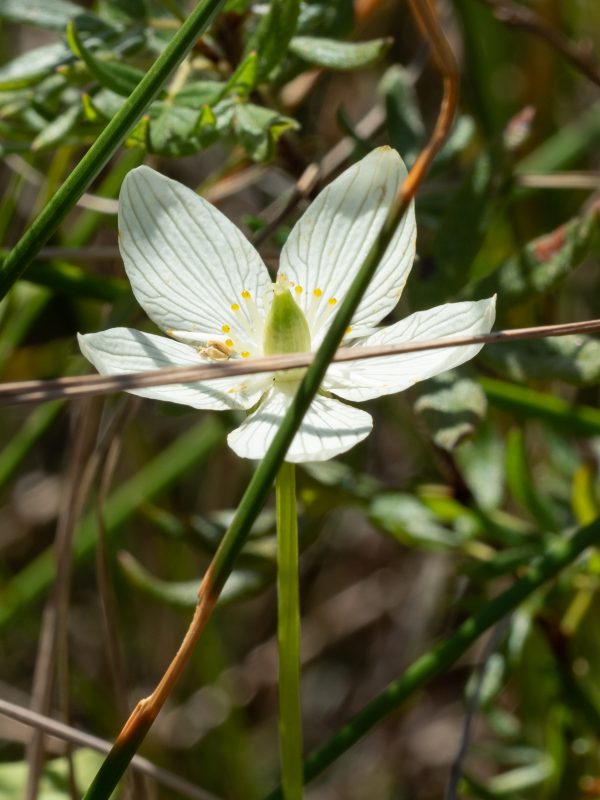
Grass of Parnassus, definitely not a grass!
Oooh look, a syrphid (flower) fly! These bee-mimics can be important pollinators, as the avidly visit flowers. This one, according to my new “Field Guide to the Flower Flies if Northeastern North America” (Princeton Field Guides) appears to be Helophilus fasciatus.
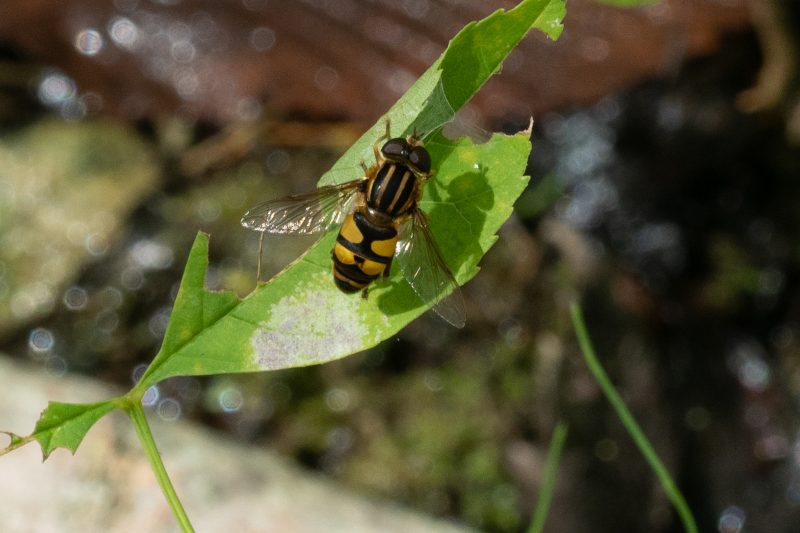
A narrow-headed march fly, Helophilus fasciatus.
FIELD TRIP 1
Deep Woods Farm (Hocking Hills Region)
This is a private nature preserve in Hocking County. The Hocking Hills is in the unglaciated portion of Ohio, where the substrate is acidic sandstone. As shown above, Dr. Forsyth listed plants associated with this bedrock type in her article. We were able to observe several of these on the trip there: chestnut oak, sourwood, and hemlock. Here’s sourwood, Oxydendrum arboreum, a tree that is a member of the Ericacae, a markedly acid-loving family of mostly shrubs and herbs.

Sourwood is an acid-loving tree with leaves that taste pleasantly tart.
We saw the chestnut oak; I was too busy to snap a photo this year. It is illustrated so well in E. Lucy Braun’s “Wood Plants of Ohio” Chestnut oaks serrations are round-tipped as compared to those of chinquapin oak, a species we hope to see next week at Cedar Bog that isn’t a bog.

Two similar white oaks with different geological substrate affinities.
from E. Lucy Braun (1961) The Woody Plants of Ohio (OSU Press)
Another of the acidophiles that Forsyth mentions is an orchid, the pink lady’s-slipper, Cypripedium acaule. This plant flowered in late Spring, and now is maturing fruit. The fruit is a capsule filled with a great many dust-like seeds.
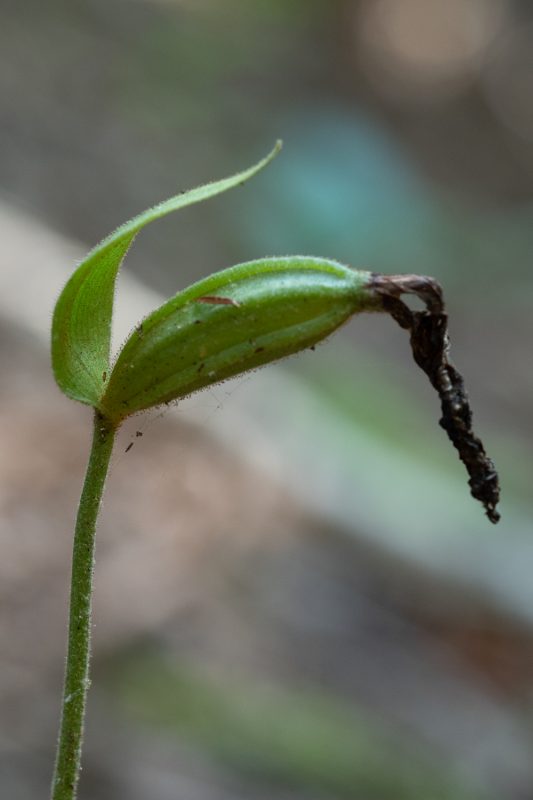
Lady’s-slipper orchid is setting fruit.
We started the foray on a shallow-soil glade-like ledge that was home to a bed of mosses and lichens. particularly “dixie reindeer lichen” (not shown) and Ohio haircap moss, Polytrichum ohioense.
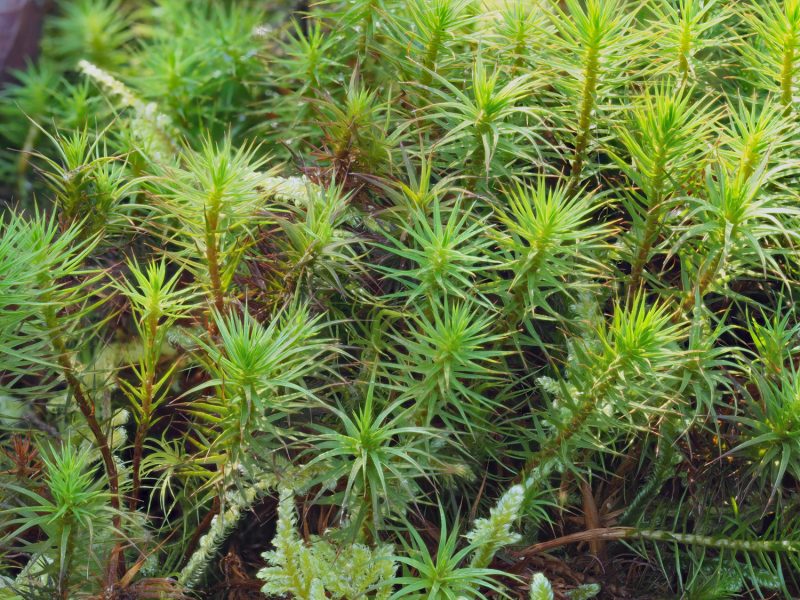
Ohio haircp moss is a robust acrocarp of open sites.
The ledge is an area of low nutrients, so is is not surprising to see members of the pea family, Fabaceae, as they are capable through the actions of bacteria in their roots, to “fix” (acquire) atmospheric nitrogen. This wildflower, especially welcome at a time when there are few others in bloom and nearly all of them are asters, is creeping lespedeza, Lespedeza procumbens.
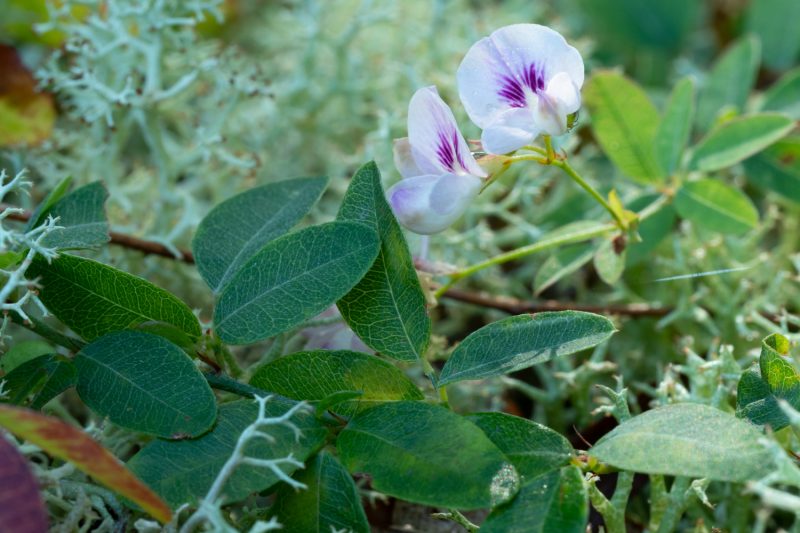
Creeping bush-clover is a member of the fabulous Fabaceae.
The ledge overtops a deep recess that we visited with a particular target in mind.

A deep recess where the Appalachian gametophyte thrives.
The Appalachian gametophyte is a fern that lost its sporophyte! A member of a tropical genus, Vittaria, this plant was once thought to represent the gametophye stage of a fern native to the southeastern U.S. Indeed, that was what
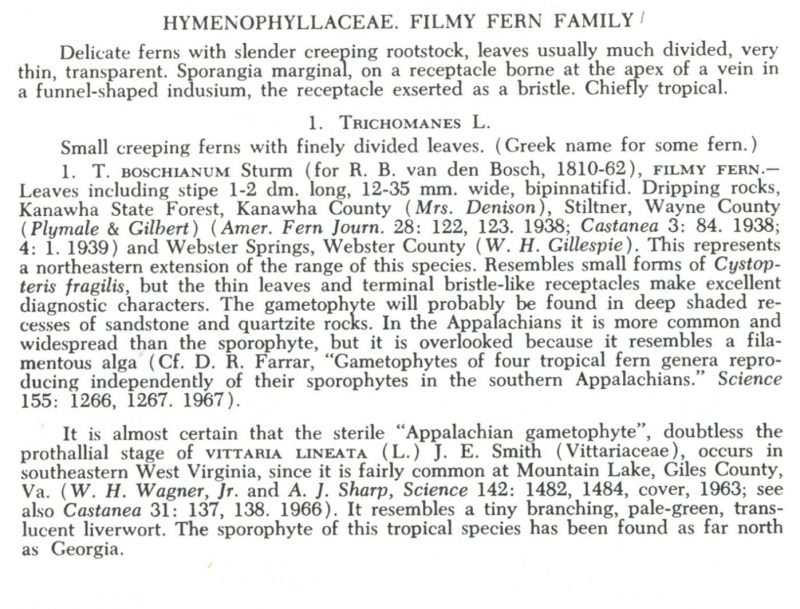
Doubtless?
The excerpt above is from “Flora of West Virginia,” by P. D. Strausbaugh and Earl L. Core. Flora of West Virginia was originally published in four parts, beginning with part one in 1952 and ending with part four in 1964. A group of six botanists from West Virginia, Maryland, and North Carolina is updating the book for future publication. If I were hired to write the description of the Appalachian gametophyte for the new edition I would carefully read the 2016 American Journal of Botany article, “Unraveling the origin of the Appalachian gametophyte, Vittaria appalachiana” by Jerald B. Pinson and Eric Schuettpelz (American Journal of Botany).
Among fern species with long-lived gametophytes, perhaps none is as peculiar as Vittaria appalachiana. The “Appalachian Gametophyte” is one of only two ferns in our area that exist only as a gametophyte (the other one is weft fern, Crepidomanes intricatum, with an appearance much like a filamentous alga).

Appalachian gametophyte in cave at Deep Woods.
The Appalachian gametophyte resembles a thallose liverwort, being flat, translucent, and one cell thick. It doesn’t produce any gametangia, but reproduces only asexually by means of threadlike gemmae extending off of the margins. The gemmae are visible in the image above.
Pinson and Schuettpelz conducted a genetic analysis of Vittaria applachiana in which they discovered that it is not (as Strausbaugh and Core) the gametophyte of Vittaria lineata, but more closely related to a South American species, V. graminifolia. Because gemmae are so inefficient at long-distance dispersal, and the fact that the species is absent from previously glaciated regions of the northeastern U.S. where conditions seem suitable for it to grow (cool moist dark recesses in sandstone cliffs), the authors assert that the most likely explanation for its presence in the Appalachian region is not from dispersal from sothern sites where the fern carries out its entire life cycle. Rather, it seems to be a relic from pre-glacial times when conditions were more tropical and the fern thrived here. Cooling eliminated the ability for the fern to persist except in sheltered spots where the gametophye could persist, but only as an asexually reproducing entity.
Moss is boss! My special project at Deep Woods was to find and photograph several mosses. It was fun as usual to see the more well-lit walls of the natural bridge near the cave where the Appalachian gametophyte grows to be well occupied by cheerful rosettes of a distinctive cushion moss, Atrichum angustatum, recognizable by the longitudinal ribbons of tissue (lamellae) running along the leaf mid-nerve (costa).
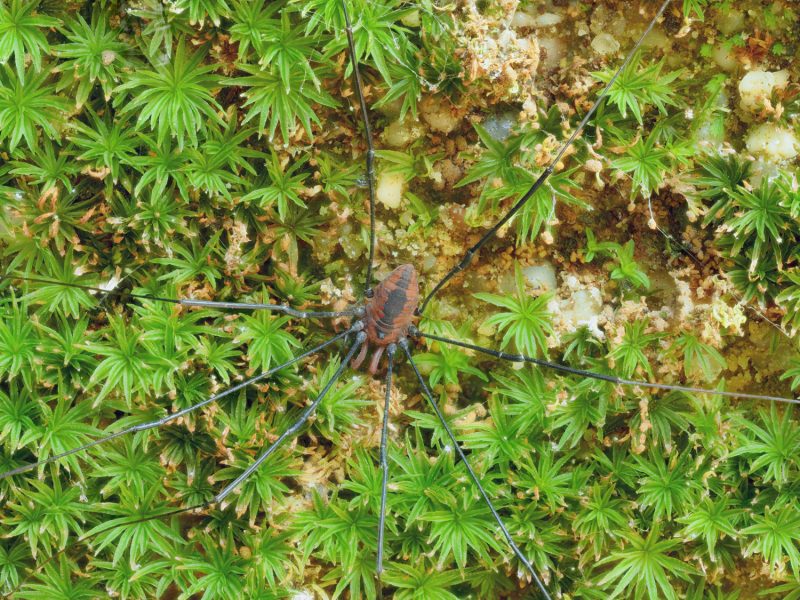
Atrichum angustatum has lamellae on the costa!
Nearby, on an even sunnier but still damp ledge is an unusual moss that Natureserve Explorer calls “boar moss” (insert interobang here) ), but I’d prefer “cheerleader moss” for Brothera leana because the clusters of brood leaves in cute fluffy tufts are reminiscent of pom-poms.

Brothera leana should be called “cheerleader moss.”
Look, a turtle!

Look! A turtle!!
